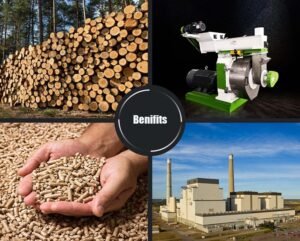
The demand for high-quality animal feed is on the rise, driven by the growing livestock and poultry industries. For small to medium-sized operations, a 1-2t/h small feed making machine offers an ideal solution for producing nutritious feed pellets efficiently. However, selecting the right machine can be challenging due to the variety of options available on the market. This article outlines key factors to consider when choosing a 1-2t/h small feed making machine, ensuring that you make an informed decision that aligns with your production needs and business goals.
1. Determine Your Production Needs
Before selecting a small feed making machine, it is essential to assess your specific production needs.
- Feed Type: Different types of feed require different processing methods. For example, poultry feed, livestock feed, and aquaculture feed may have distinct formulations and processing requirements. Understanding the type of feed you intend to produce will help narrow down your options.
- Production Volume: Consider your desired production volume and frequency. A 1-2t/h machine is suitable for small to medium-scale operations, but you should evaluate whether this capacity meets your current and future production needs. If you anticipate growth, you may want to choose a machine with a slightly higher capacity or the option to expand in the future.
2. Evaluate Machine Features
When selecting a small feed making machine, consider the features and specifications that will impact its performance and efficiency.
- Pelleting Process: Different machines employ various pelleting processes, such as flat die or ring die. Ring die pellet mills are typically more efficient for larger production volumes and provide better pellet quality. Assess which type aligns with your production goals.
- Material Compatibility: Ensure that the machine can handle the raw materials you plan to use. Common materials include corn, soybean meal, wheat, and various additives. Check the machine specifications to confirm that it can process these materials effectively.
- Energy Efficiency: Energy consumption is a significant factor in operating costs. Look for machines that are designed for energy efficiency, as this can lead to substantial savings over time.

3. Consider Quality and Durability
The quality and durability of the animal feed manufacturing machine are crucial for ensuring long-term performance and reliability.
- Material Construction: Machines made from high-quality materials, such as stainless steel or hardened alloy, are more durable and resistant to wear and tear. Assess the construction quality of the machine before making a purchase.
- Brand Reputation: Choose a reputable manufacturer known for producing reliable and high-quality feed making machines. Research customer reviews and testimonials to gauge the performance and durability of the machines offered by different brands.
- Warranty and Support: A good warranty and after-sales support are indicators of a manufacturer’s confidence in their product. Ensure that the machine comes with a comprehensive warranty and that the manufacturer offers technical support and spare parts availability.
4. Assess Maintenance Requirements
Regular maintenance is essential for the optimal performance of any feed making machine.
- Ease of Maintenance: Consider how easy it is to access and maintain various components of the machine. Machines designed with user-friendly features, such as easy access panels and modular components, can simplify maintenance tasks.
- Maintenance Schedule: Review the manufacturer’s recommendations for routine maintenance and servicing. A machine that requires frequent and complex maintenance may lead to increased downtime and operational costs.
5. Analyze Costs
Cost is a critical factor when selecting a small feed making machine, but it should not be the only consideration.
- Initial Investment: Evaluate the purchase price of the machine, including any additional costs for installation and setup. Compare prices among different brands and models to find a machine that fits your budget.
- Operating Costs: Consider the ongoing operating costs, including energy consumption, raw material costs, and maintenance expenses. A more efficient machine may have a higher upfront cost but can lead to lower operating costs in the long run.
- Return on Investment (ROI): Calculate the expected ROI based on your production capacity and market demand. A machine that allows you to produce high-quality feed efficiently can lead to increased profitability.
6. Check for Customization Options
Every feed production operation has unique requirements, and having a machine that can be customized to meet those needs can be beneficial.
- Adjustable Settings: Look for machines that offer adjustable settings for pellet size, moisture content, and feed formulation. This flexibility allows you to produce a variety of feed types and adapt to changing market demands.
- Additional Equipment: Consider whether the manufacturer offers complementary equipment, such as mixers, crushers, and packaging machines. A complete production line can enhance efficiency and streamline operations.
7. Seek Expert Advice
If you are unsure about which small feed making machine to choose, consider seeking advice from industry experts or consultants.
- Consultation Services: Many manufacturers offer consultation services to help you assess your needs and recommend suitable machines. Take advantage of these services to gain insights into the best options for your specific situation.
- Field Visits: If possible, visit existing operations that use the machines you are considering. Observing the equipment in action can provide valuable insights into its performance and suitability for your needs.
Conclusion
Choosing the right 1-2t/h small feed making machine requires careful consideration of various factors, including production needs, machine features, quality and durability, maintenance requirements, costs, customization options, and expert advice. By thoroughly evaluating these aspects, you can select a machine that aligns with your operational goals and contributes to the efficient production of high-quality animal feed.Investing in the right feed making machine not only enhances productivity but also ensures that you meet the growing demand for nutritious animal feed in a competitive market. With the right equipment, you can improve your feed production process, increase profitability, and support the health and growth of livestock and poultry.
For details please contact: Richi Pellet Machine
WhatsApp:86 138 3838 9622
Email:enquiry@richipelletmachine.com





